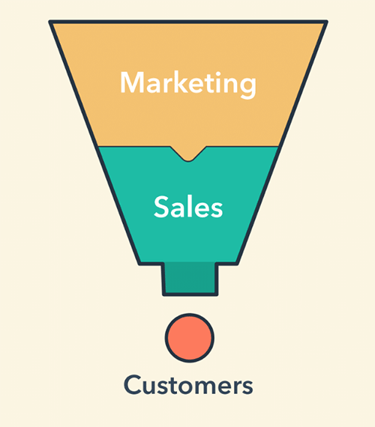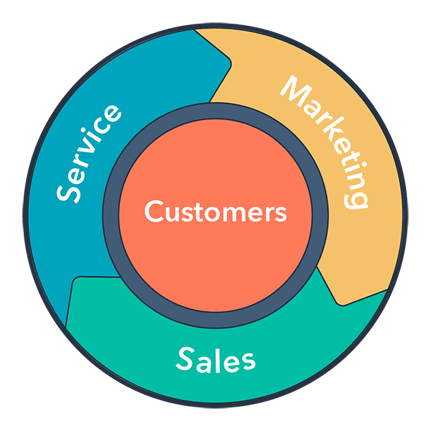While the principal purpose of your “customer service” team is to prioritise customer happiness, the problem is that many modern businesses today – driven by the need to close deals and generate revenue – have a tendency to forget their relationship with customers after the initial sale and simply move on to the next prospect.
The problem with this approach is that businesses miss out on opportunities to deliver more value to their customers, customers who, in time, could become evangelists or advocates for these businesses and help them to raise their profiles.
Simply pushing customers through a sales funnel to a point of purchase without providing any additional value after the close date is no way to generate more business. For many businesses, the whole idea of a customer becoming an evangelist or advocate for the business isn’t even considered!
However, businesses that place their customers at the centre of their marketing initiatives gain a clear advantage and a competitive edge. It’s important to appreciate that the buyer/seller relationship has changed – customers have more control over the buying process, more alternatives, and ever increasing expectations.
Your best marketing tool could potentially be your customers saying nice things about you. Think about how you hear about great restaurants; as well as searching for them online and reading customer reviews, you probably hear about high-quality restaurants from friends and family who have visited them.
The fact is that your customers are quickly becoming your best and most vocal salespeople.
Your customers speak louder than you do
Word-of-mouth, referrals and reviews have always been some the most effective ways for businesses to build their profile, gain exposure, and attract new customers.
In an era where Google has a huge influence on the amount of web visitors and leads you generate, and customer reviews and referrals can increase your business’ exposure, having a website, keeping your customers happy, and helping your customers to succeed will help your business to succeed too.
But while the customer has always been at the heart of marketing – the customer now needs to be at the heart of every business’ overall marketing and sales strategy.
Realising that some businesses have forgotten the importance of building and enhancing relationships with existing customers, HubSpot have created the Service Hub – their new customer service software 100% focused on delivering a better customer experience.
Marketers and salespeople, it’s time to move away from the linear approach of generating leads, converting them, closing them as customers and never speaking to them again.
It’s time to turn your marketing and sales activity into a cyclical, customer-centric process where you are always delivering value to your customers, and they in turn are saying nice things about you at every opportunity.
It’s time to go from this:

(Image source: HubSpot)
To this:

(Image source: HubSpot)
HubSpot’s flywheel (pictured above) represents a smarter, cyclical way of thinking about how customers interact with your business at every stage – and the HubSpot Service Hub was developed to support this customer-centric process.
Of course, engaging with customers throughout the entire process and across multiple channels requires the right tools – and that’s just one way the Service Hub can help.
How can the HubSpot Service Hub improve your customer service?
Converse with your customers across channels
Within the Service Hub is a tool called Conversations. Customers today use a number of social channels to engage with businesses – Facebook, Twitter, LinkedIn, email, live chat – so to make it easier for businesses, the Conversations tool brings all of the communication across these channels into one universal inbox for everyone to see. It doesn’t matter if a contact emails you or sends you a message on Facebook, you can respond to them via the same platform from within the Service Hub.
Using the Conversations tool, your whole team can collaborate on messages in one spot, and communicate with customers via the channel they reached out on originally. As it’s built on the HubSpot CRM, conversations are contextualised, meaning you know who you’re talking to and have access to all the information you need from a marketing and sales perspective.
Help customers to help themselves
Answering the same questions from your customers over and over again can be frustrating but more importantly – time-consuming.
Instead of answering those questions over and over, you can use the Service Hub to create a knowledge base – a directory of high-quality articles designed to solve customers’ issues and provide valuable insights. Using a knowledge base you can help customers to help themselves by directing them to a valuable resource, minimising the number of tickets you receive.
Articles can be quickly created and a reporting dashboard helps you to understand how good a particular article is at solving customers’ issues.
Address customer issues with ease
Another key component in the Service Hub is the Tickets tool. Tracking customer issues and queries manually via email is impractical and, as your business grows, unsustainable.
The Tickets tool within the Service Hub provides a way for you to track, order, collaborate and meet your customers’ needs and expectations. Tickets can be associated with HubSpot contacts so all of your teams will know if a contact has an open issue that needs resolving. All of the tickets come together to form a ticket board in the Service Hub – a centralised place for your support team to go when issues need resolving.
Understand your customers and their expectations of your business
Once all the above is in place and you are helping your customers along their purchase journey, you then need to ask customers for feedback to help you improve your approach and better understand their needs.
And – yet again – there’s a tool just for that within the Service Hub – it’s the customer feedback tool. Using the tool you can build a series of surveys that you can use to capture feedback from your customers – these surveys can be comprised of simple yes or no questions or a little more comprehensive.
By regularly surveying your customers you can build an understanding of what they expect from your support team and your business as a whole. This will then allow you to refine your marketing campaigns to be more specific and customer-centric. Also, as you receive responses from customers you will be able to see who your biggest advocates are – more opportunities for content creation (particularly in the form of case studies and reviews).
Start taking a customer-centric approach to your marketing and sales activity
Rethink the way you engage with your customers and start building your strategies around them. Your customers are your best salespeople and are far more influential than any of the content you produce.
With the HubSpot Service Hub, you can reshape your marketing and sales activity, help your customers to succeed, and grow your business.
What are you waiting for?
If you want to transform your marketing and sales activity and actively engage with your customers throughout any activity - we can help! We regularly run classroom-based HubSpot marketing and sales training, so why don't you come on down?









.png)





